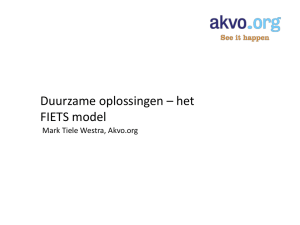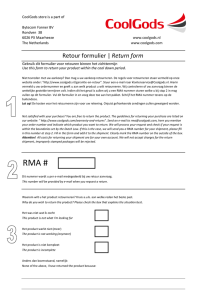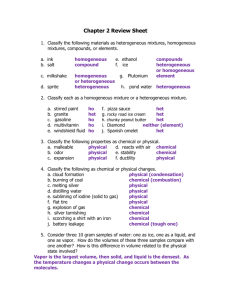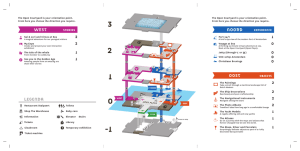What made Harrahs an Innovation Leader?
advertisement
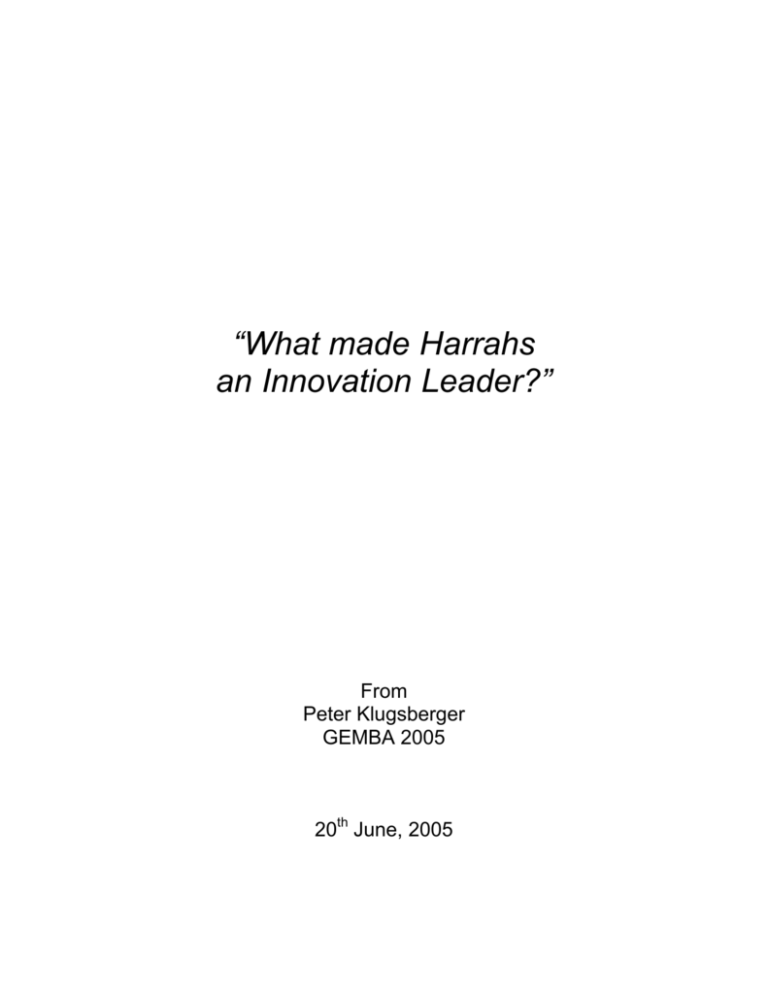
“What made Harrahs an Innovation Leader?” From Peter Klugsberger GEMBA 2005 20th June, 2005 ‘What made Harrahs an Innovation Leader?’ 1. Introduction Apart of the hourly erupting volcanoes, sinking Pirate ships and replicas of the Eiffel Tower, one might argue that the only thing the North American casino industry has invented is an especially effective way of parting willing consumers from their cash. However, as in many other industries that entered into a mature life-cycle stage, customers’ expectations evolved notably over recent years and people’s demands for an improved customer service experience forced many of those gambling empires to rethink their strategies and adapt to the rapidly changing business environment. This report sets out to look at one of these incumbents, Harrahs Entertainment (HET), with a particular focus on how it transformed itself into one of the most innovative companies in the gaming industry. 2. Industry background The core product or revenue generators of a casino, the table games and slot machines, are in essence commodities which are easily replicated by any new entrant or competitor due to their availability in the market place. For that reason, one of the few areas of potential differentiation for a casino is in providing a unique customer experience in form of either building a ‘must-see’ property or through increased customer service levels. Over the last two decades the North American market was dominated by four major gaming empires. Three of those, namely MGM Grand, Caesars, and the Mandalay Group were following the ‘must see’ property strategy. Contrary to those aforementioned players, Harrahs decided that the huge capital costs of developing these ‘glorious’ properties did not prove a viable alternative in achieving long-term market growth – instead they chose to develop a core competence around customer loyalty. Prepared by Peter Klugsberger -1- Strategy Implementation ‘What made Harrahs an Innovation Leader?’ The gaming industry has never been known, until recently, for pushing established boundaries or to be especially innovative. Many of the advances in the design and development of new products and services were primarily achieved by means of incremental innovation rather than by endeavouring to break out of the mould. 3. About the company Harrahs was founded in May 1937 in Nevada by William Fisk Harrah, a 26year-old entrepreneur. By 2002, HET grew to be a major player in the gaming industry consisting of 26 casinos in 17 different cities. Phil Satre, who became CEO in 1984, focused his initial strategy around people. Under his reign, Harrahs developed a rewards program based on tracking cards (akin to a frequent flyer program) at each of their properties. However, this program was run independently and therefore took totally different forms at each property. By the mid 1990s, HET felt the competitive pressures and attributed sizeable losses in market share to the ‘must-see’ properties. HET was at the crossroads in deciding if it wanted to imitate this approach or discover new ways of competing – one thing was clear, something had to change. In an attempt to avoid the enormous development costs, Harrahs decided against imitating its competitors approach and rather focus on becoming market leader in building and maintaining close customer relationships. However, Phil Satre understood that to succeed in his attempt to turn the company around, he needed to adopt a more radical new business system and at the same time discard the present functional approach that held the company and its people virtually captive in the past. Prepared by Peter Klugsberger -2- Strategy Implementation ‘What made Harrahs an Innovation Leader?’ For that matter, I am going to look closer at each of the critical areas that were essential in the transformation process from pursuing a ‘follow-theleader strategy’ to becoming an innovation leader in the gaming industry. 4. Leadership A year after analysts questioned the company's viability, Phil Satre understood that he needed a person that not only had a clear vision but also possessed the necessary competence and determination for turning the company’s fortunes around. Getting to the root causes of HET’s poor performance required a special kind of person that could shake up current organisational structures and break the somewhat inward-looking mentality of HET’s people. The CEO also recognised that his problems could not be solved by merely creating another marketing position – for the transformation process to have any kind of credibility they had to bring in somebody as the COO. This was a critical success factor since for a person to generate changes in the operating business, he/she needs to be equipped with the authority to say “this is the way we are going to engage our customers”. The CEO settled on a choice so unconventional that he didn't tell his board about it until it was a done deal. The surprising choice fell on Gary Loveman, a Harvard Professor that specialised in relationship-marketing and who contacted Satre with an unsolicited proposal to expand HET’s business activities. Given the risks involved, I believe that this was a bold but necessary move to take on an outsider – a person that could see the problems of the company without having any mental preconception such as ‘I am the industry expert and I know what needs to be fixed’. One of the major advantages the new COO had, was the fact that he did not have to unlearn established mental models or felt that he had to follow unwritten rules - he could allow himself to approach the Prepared by Peter Klugsberger -3- Strategy Implementation ‘What made Harrahs an Innovation Leader?’ company without limiting his imagination to what were the necessary steps to achieve market growth. Initially, most of the HET employees were reluctant to trust their new CEO, in particular since they did not feel that the Harvard Professor had what it takes to succeed in the gaming business. They were not entirely wrong in their first assessment – until then, Loveman had managed only one secretary and a research assistant and now was in charge of 26 casinos, 15,000 hotel rooms, more than 100 restaurants, and 40,000 employees. For a new and innovative environment to emerge, Loveman had first to dismantle employee’s past mental attitudes and patterns of behaviour that were not aligned with his vision of wanting to create a national brand that truly inspired customer loyalty. For example, one of his first important decisions as COO was to replace the existing marketing people. He took out practically the entire corporate marketing department since he figured from the onset that they were never going to support his change program and take it where it needed to go. Instead of attempting to change the incumbent people’s attitude, he recognised it was highly unlikely that he would win this battle. Consequently, for his vision to become reality he imaged a different kind of employee that they had right now - one that had the horsepower to do this kind of work. He searched for the best and the brightest and contracted several customer relationship ‘rocket scientists’ from outside the gaming industry. This was an interesting and valid choice, in particular since it provided the company with new people with different talents and a fresh outlook. Getting people to see a problem with from different angle was a good way of breaking the inherent ‘groupthink’ mentality. Suddenly, people were focused on customers’ wants & needs instead of following the daily ‘business as usual’ routine. Prepared by Peter Klugsberger -4- Strategy Implementation ‘What made Harrahs an Innovation Leader?’ Another important characteristic of Loveman’s leadership style that was conducive to innovation was to involve himself in initiatives that he felt were instrumental to accomplishing his vision. For example, he chaired the newly created marketing council which brought together field-marketing people as well as outside agencies, PR agencies, and senior technology persons. The creation of this cross-functional heavy-weight team was vital in communicating to employees that coming up with a new marketing concept was a top-priority for the new management. In addition, the composition of these teams was deemed extremely significant since much of marketing was running through technology systems that had to be managed by Information Technology (IT). Members of this council understood that HET’s marketing work was a collaboration between corporate and the field and that everybody owned their decisions and was held accountable accordingly. Here, I found some similarities in the approach to the Harvey Gollub case (American Express), where Mr. Gollub participated in various initiatives and teams to exhibit top-management’s commitment. Given that for senior manager’s the most important resource is time, a project or initiative is deemed key by middle- and low-level staff if the manager is physically present at those meetings. At the same time, the COO and this marketing team started to experiment with quantitative mathematical models that accurately predicted “customer future worth”, thereby adding decision science capabilities to the company. As a result, the gained player information, which was made accessible throughout functional departments, could be used to improve service levels and satisfy customer’s needs in a more effective and efficient manner. Many of the general manager’s of the 26 Harrahs properties had initial reservations about the usefulness of this system but were happy to adopt it after realising that it improved their decision-making abilities through providing more accurate and timely data. Given that those managers saw that this could Prepared by Peter Klugsberger -5- Strategy Implementation ‘What made Harrahs an Innovation Leader?’ make them more money, they were happy to adopt these new processes without putting up a major fight. Nevertheless, it was also imperative for Loveman to have the authority to make the use of these tools mandatory. He often used to question his managers in operating meetings and ask “what is wrong with segment 452 here in this city?” – needless to say that if they were not using the right tools effectively they would find themselves in a lot of trouble. Breaking people’s old habits and the way the used to look at problems is essential ingredient to foster an innovative environment. Trying to change people without having the required authority would, in most cases, be a sheer unworkable undertaking. 5. Strategy Harrahs strategy making process focused primarily on its customers and their respective behaviour. The company collects information on their 26 million customers through their use of personalised frequent-gambler cards, called ‘Total Rewards’. This data in turn is then used to refine the company’s database, which included 90 targeted demographic segments of each of which receives custom-tailored direct-mail incentives to visit any of the 26 Harrahs properties. The company can trace 75.6% of its gambling revenues back to specific customers. In its latest annual report, HET stated, "We know what our customers like," then provided examples of the kind of detail the company tracks. "Tom likes NASCAR, Clint Holmes, thick steaks. Joyce and Ted like oceanfront views, barbershop quartets, Elvis slots. . . ." This constant scanning for changes in the business environment through analysis of their customer data gives Harrahs a clear advantage over its competitors. Any deviation or changes in predominant customer taste or Prepared by Peter Klugsberger -6- Strategy Implementation ‘What made Harrahs an Innovation Leader?’ behaviour will be immediately picked up by the system and the company is able to adapt its strategy rapidly to match to those novel circumstances. It would take weeks if not months for any of Harrahs’s competitors to notice a similar customer drift, thereby making it tricky to readjust their strategies as fast. This closeness to the customer and the use of a positive and negative feedback loops enable HET to verify that everything goes according to plan – meaning that the strategy either works or needs to be tweaked. However, one of the drawbacks of this system is that it does not tell Harrahs much about the implicit future customer needs. For example, people might never had the desire to eat in an exotic restaurant but if they would try they would really enjoy it. So the customer will not be able to explicitly communicate his/her future needs but rather what is important at this moment. On the other hand, HET’s systems are continuously growing to be more sophisticated and collect more and more data about their customers. This, in essence, will lead the company even closer to the fabled ‘one-to-one’ customer relationship. Interestingly, Harrahs also uses its database to decide when to pull back from a customer relationship. Empirical evidence has shown that a significant part of a company’s regular customer base is too expensive to service and HET consequently should aim to discontinue the relationship. Up to recently, it was difficult if not impossible to easily identify these unprofitable segments and therefore was hard to improve HET’s overall marketing effectiveness. Now that HET is able to exactly predict each individual’s worth to the company, it is estimated that they will realise more than $ 20 million in annual savings through the respective increases their marketing effectiveness. Being able to sustaining this competitive advantage in the long-term is one of Harrahs main priorities. HET does so by protecting is innovative processes and knowledge through proprietary means – they have won seven patents for various parts of their customer tracking systems which gives its business the necessary edge without ever having to fear of their competitor trying to Prepared by Peter Klugsberger -7- Strategy Implementation ‘What made Harrahs an Innovation Leader?’ reproduce their innovative processes. What is even better, Harrahs actually may licence its intellectual property or settle on some other form of compensation if other gaming operators try to duplicate Harrahs system. Using the ‘value creation disciplines’ of Treacy and Wiersema, I would describe HET’s sources of competitive advantage in the categories of ‘customer intimacy’ and ‘operational excellence’. In Harrahs’ case, there is a clear preference to reach the customer on a personal level, mainly by trying to learn as much as possible about them. This knowledge in turn helps the company to serve their clients better but at the same time significantly improves their operational effectiveness. For example, if a customer lives close to the casino property he/she will rarely receive an offer for a free night at the hotel since the likelihood of that person to accept that offer are rather slim. Conversely, if the customer is a regular in the casino’s restaurant, the likelihood to accept a free steak dinner invitation is relatively high. 6. People management and organisational design According to Gary Loveman, one of his biggest achievements in HET’s turnaround process was the cultural change by instilling a meritocracy. In the early days of the company, people were considered adequate if they were meeting the minimum required standards of the job. Loveman personally conducted talent reviews with all of his operating and corporate people and used these occasions to instil the different notion in his executive’s mindset. His argument was that “why would you spend time trying to make a barely OK person successful? Wouldn’t you rather have a case where employees are so good that they are putting some heat on you and teaching you some things and pushing you around a little bit?”. Given the fact that the casino industry can be described as a ‘people business’, it is evident that having a competent and motivated workforce is essential for a company to stay ahead of competition. I was amazed on how many companies still Prepared by Peter Klugsberger -8- Strategy Implementation ‘What made Harrahs an Innovation Leader?’ perceive their people’s performance reviews as a quasi low-key social interaction, whereby results often beard little to no influence on the employee’s future career prospects. HET recognised that it missed a big opportunity here and if they wanted to excel in the ‘customer intimacy’ value discipline, they required capable and motivated employees to manage a consistent service delivery. Another important aspect of the changes in HET’s culture to a more innovative climate was related to treating people as assets rather than seeing them as mere cost-centres. Despite many declarations of top management in annual reports or corporate brochures, the amount of companies that invest in improving their workforce’s skills and knowledge is far and few between. Loveman deemed this a big opportunity and focused on reducing HET’s employee turnover. Not only did he change the hiring process to ensure a better match between people’s abilities and the job requirements but, moreover, he also ensured that they knew what they are being hired into. This was achieved by offering people “job previews”, whereby they get acquainted with the work they will do before they actually start. In addition, supervisors are there to give support to new potential employees by regularly checking in with them and see if they are happy with their working environment. HET appreciated that to improve its employee’s willingness to work across functional areas and thus improve internal communication; it had to change its performance management system. From 1999, Loveman started paying out a bonus to every non-management employee of the casino if his or her property improved its customer service scores by 3 percent over the same period a year earlier. The company paid out $40 million in bonuses to employees across the system – anywhere from $75 to $300. Again this change in the corporate culture would have never been possible without giving Loveman the necessary authority of the COO position. Customer satisfaction surveys were regularly published in employee areas, and Prepared by Peter Klugsberger -9- Strategy Implementation ‘What made Harrahs an Innovation Leader?’ employees could check how they were doing. One positive aspect of these feedback mechanisms was that they were self-reinforcing. This means that employees were encouraged to also ensure correct service delivery in other departments, not just their own. For example, if people noticed that customers were not happy with the performance of the valet department, other areas would use peer pressure to improve that department’s service delivery. Given that the bonus payments depended on the valuation of the whole property and not just on individual performance, this effectively broke down the ‘silomentality’ of just caring for each person’s area of responsibility. This alignment in management and front-line employee’s objectives was achieved by using collective performance targets rather than individual ones. This is a good example for achieving goal congruence in support of HET’s strategy. Again, one of the key success factors here is the fostering of an environment where people are measured on the company’s overall performance, which encourages people to apply their own initiative, knowledge and skills. Finding and hiring the ‘right’ people was only one part of HET’s successful Human Resource strategy. Loveman decided to develop a ‘service curriculum’ program, which came out of the research with the company’s best customers on issues that really motivated and drove their loyalty. For the first in the company’s history, every single employee had to attend this training course. At the end of the program, everybody had to pass a test - or risked to be terminated – this harsh reality demonstrated the company’s strong commitment to this imitative. What made this project quite unique was the fact that the company paid people their tipped wages while they were in training – by doing so, HET sent a strong message about the importance of this development program. At one casino in Las Vegas, this program was run for 24 hours a day - simply to be able to capture people on all shifts. It took them around four months to get through 4,000 employees. Prepared by Peter Klugsberger - 10 - Strategy Implementation ‘What made Harrahs an Innovation Leader?’ 7. Management of key assets Harrahs key assets consist of a number of different capabilities that were built up over recent years. Many of these unique capabilities are based on highly sophisticated mathematical models, like the hotel yield-management systems and the slot-pricing systems. On a regular basis, HET gets their field and corporate people together with outside experts, design new applications, and then make their use mandatory throughout the company. Consequently, with the way the company prices the slot machines, the way they yield the hotel rooms, the way they procure things, they ought to be better than the local casinos they compete against in their respective markets. Similar to Wal-Mart, Harrahs strategy is not easily imitable since it consists of many individual capabilities that work seamlessly together but only produce results when being bundled together. One of the major strengths in this approach is the makeup of the project teams - they are comprised of a mixture of internal and external sources, thereby avoiding the trap of building up a silo-mentality. HET constantly scans its environment for new emerging technologies and for immediate practicable applications within the network of systems. For example, managers at several Harrahs casinos currently are trialling radio frequency identification transmitters (RFID) in Food & Beverage employee’s ID-cards to monitor their movements during a shift. This information will help Harrahs to decide not only on adequate staffing levels but moreover gives them possibilities to use this information in the performance appraisal process. The backbone of this system is WINet, a national database of operational customer data and a data warehouse (a central repository including both customer data and data on hourly slot machine usage). The marketing department uses the data warehouse to analyze the customer information for patterns and insights. It then creates individualized marketing programs for customers based on their projected worth. Prepared by Peter Klugsberger - 11 - Strategy Implementation ‘What made Harrahs an Innovation Leader?’ Many of the innovations of the WINet system are protected by patents, thereby generating extremely high entry-costs barriers for new entrants or incumbents. This is also the reason why it will be extremely difficult for the other major companies in the gaming industry to devise a similar technological system. 8. New product & Learning Harrahs approach to new product development and learning is intrinsically linked with the repository data gained by those millions of customer transactions. New ideas and concepts are mostly raised by the ‘propeller heads’ of the marketing department and then researched in-depth by using complex predictive models. The CIO, John Boushy, commented in an interview that he and his department were never able to anticipate the questions the marketing department might ask, so they decided to keep all customer data available. Another example of Harrahs aspiration to foster original solutions is demonstrated in the use of selected casino properties as laboratories for customer-tracking innovations. Based on data churned out of their system, Harrahs’ reworked the layout of this Chicago property by moving popular machines to hard-to-reach areas so to create more space for other games in well-trafficked areas – of course without affecting the casino’s overall performance. The theory worked and the casinos’ profit margin improved considerably without having to incurring any major capital expenditure. Harrahs’ employees also are able to use customer data to conduct ‘marketing experiments’ that track customers over time. The results of these trials are then used to fine-tune those marketing instruments and thereby inducing the desired customer behaviour. Prepared by Peter Klugsberger This evaluation of marketing tools produced - 12 - Strategy Implementation ‘What made Harrahs an Innovation Leader?’ astounding results – not only financially but moreover from a learning perspective for the people involved. 9. Closing Remarks Pinpointing what exactly made Harrahs one of the most innovative companies of the gaming industry is not an easy undertaking. It would have been nearly impossible to highlight the companies ‘best practices’ in the field of innovation without considering to delve into the HET’s transformation from being a mere follower to becoming an innovation leader. It became clear to me that the critical success factor that was key to turning around HET’s fortunes was the leadership of Gary Loveman. Phil Satre took an immense gamble on designating him as COO of the company, in particular since Loveman had never managed a turnaround of that size. In hindsight, this risky choice was the best thing that could have happened to a company that was slowly being alienated by its customers by their ever evolving needs. It was also Gary Loveman that took some courageous and difficult decisions. For one, changing Harrahs internal culture to a meritocracy must have been not only a tremendous challenge but moreover was vital to ‘clean’ house of HET’s employee’s outdated and inward-looking ‘silo mentality’. Loveman clearly understood that to turn around the company he needed fresh ideas that were not tainted by the short-sightedness of being an industry insider. What also impressed me in Harrahs strategy was the fact that they used resources that were already present in the company and used them in a different way to make them into new capabilities. Starting their ambitious customer relationship program, Loveman used the 300 Gigabyte ‘old’ customer data base to experiment with his newly created sophisticated Prepared by Peter Klugsberger - 13 - Strategy Implementation ‘What made Harrahs an Innovation Leader?’ mathematical models. This research formed the basis of the now legendary ‘Total Rewards’ loyalty program. Prepared by Peter Klugsberger - 14 - Strategy Implementation
